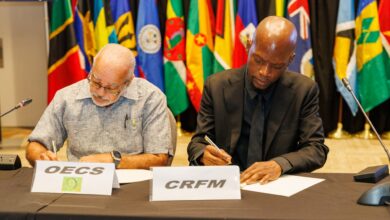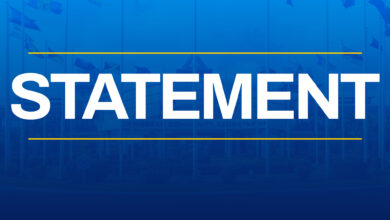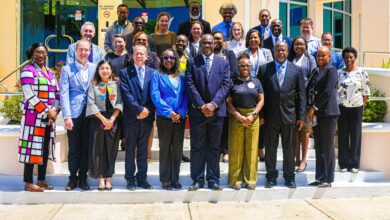Thank you for inviting me to participate with you in this important dialogue. It was a pleasure for me to accept the invitation, not only because of the special regard and respect I have for ANSA MACAL, but because of the opportunity this has afforded me to interact with key members in the regional private sector, a sector which has a critical role to play in the implementation of the ongoing project that we call the CARICOM Single Market and Economy.
I must confess though that when I saw the title of the presentation I was being asked to make today, CARICOM : THE PROMISE AND THE REALITY, I did for a second wonder whether I dared to face a group of hard nosed businessmen to discuss the success of CARICOM in over two and a half decades of its existence. But I must admit that I was also intrigued. Furthermore, I am convinced that the dream which was shared by our predecessors of CARICOM being a people and a Region united in a common bond promised a great deal which has not yet been achieved. Undoubtedly, however, some achievements, quantitative and qualitative, have been made towards making that dream a reality. I therefore concluded that there is much we could both learn from this exchange. So intrigue and, dare I say, conviction, won the day.
Almost twenty-five years after establishing a Caribbean Community, it is fair to ask what is this dream we had of integration when our heads of Government signed the Treaty of Chaguaramas? What was the promise? Is this dream still relevant to the current reality of the Caribbean a year into a new century with a changing paradigm of economic development?
The Treaty of Chaguaramas (1973) states that the Governments of the contracting states agree to have as their objectives:
1. The economic integration of the Member States by the establishment of a common market regime;
2. The coordination of the foreign policies of Member States;
3. Functional cooperation, including:
•the efficient operations of certain common services
•the promotion of greater understanding among its peoples and the advancement of their social, cultural, and technological development.
To start with the last objective first, there is not always a full appreciation in this Region – and that may be partly our fault – of the extent of CARICOM cooperation in areas such as health, education, culture, and indeed in many other areas of social development. The number of functioning regional institutions in a range of areas attest to this. They range from the Caribbean Examination Council to the Regional Nursing Body and the Association of Police Commissioners. I do not have to tell you about CARIFESTA, the most powerful expression of our cultural identity and kinship – a public demonstration of our daily interaction as a people with a common destiny.
Even less known are the countless actions of cooperation among policy makers and practitioners in labour, health, education, and disaster management, for example, which take place in an ongoing basis in the Region. These are all expressions of the reality of interdependence among our group of small states seeking to survive in a difficult world.
Co-ordination in the area of foreign policy as promised by the Treaty is more complex, probably because the clearest demonstration of independence and sovereignty is perceived to be the capacity to conduct one own’s foreign policy. Consequently, no political leader is likely to give up that right easily, particularly after having struggled for independence. It has take a new paradigm in global relations for our leaders to recognise and fully appreciate that sovereignty means little without the enhancing capacity to influence external events and that for small countries such as ours, such influence can only be achieved by joint action in international relations.
Today, given the realities of a globalised world unsympathetic to the problems of small states, CARICOM acts jointly in the development of its external economic relations, be it in Brussels, or Geneva, or wherever the framework for global trade and investment is being developed, as well as in other capitals. So much has the regional agenda become an integral part of the national agenda that countries which do not export one banana, for example, such as The Bahamas and Trinidad and Tobago, continue to embrace the common regional position on the EU/ACP banana regime in their pronouncements and in the conduct of their relations with third parties.
We have just come from a meeting of the Prime Ministerial Committee on External Economic Relations where the Region agreed on joint strategies and common action to prepare for negotiations in the Free Trade Area of the Americas, with the European Union, and for approaching discussions in the WTO on new global relations.
Notwithstanding the severe pressures on CARICOM to act unilaterally, we have largely been able, for example, to respond to the powerful OECD lobby on harmful tax competition as a Community. We participated in the hemispheric summit in Quebec City as a Community. We had dialogue with the new government in Washington on a framework for bilateral relations as a Community. We will be approaching the UN General Assembly Special Session on HIV/AIDS as a Community.
Equally importantly, we are perceived and lobbied by third countries needing our support as a Community of nations, and in that fact lies our strength and capacity to influence outcomes in the international arena even in small but important ways that affect our livelihood.
The Region’s ability to jointly develop and implement policy will be strengthened with the functioning of the Quasi-Cabinet which gives regional responsibilities for certain areas for development to lead heads of Government.
Now to the business of economic integration. The 1989 Meeting of the Conference of Heads of Government in Grenada was a crucial milestone in the resolve of CARICOM Leaders to advance the process of regional economic integration. It would be recalled that the initial efforts at economic integration was to establish a free trade area – CARIFTA – which was subsequently matured by the 1973 Treaty of Chaguaramas into a CARICOM Common Market. This involved mainly free trade in goods, a common external tariff and coordination of macro-economic and sectoral policy. The focus on trade in goods to the exclusion of labour, capital, services, etc. rendered that arrangement of limited capacity for the development of the Region. Thus, though successful in relation to the free movement of goods – more than 90% of regionally produced goods are traded in CARICOM free of duty and quantitative restrictions – such an arrangement had to be enhanced if it were to adequately protect and advance the Region’s position in today’s liberalised and globalised world.
At that Tenth Meeting at Grand Anse, Grenada, Heads of Government confronted this issue frontally. The then Prime Minister of Trinidad and Tobago stated on that occasion:
Within the last three years the political will to address the obstacles tot he fulfillment of our dreams and those of our illustrious predecessors have been considerably strengthened. Consequently, the time is propitious for a major re-examination of where we have reached in our efforts at integration and where we want to go. Against this background of our conclusions of this exercise we can revise our goals setting dates and targets and challenging ourselves to new levels of cooperation.
And our Leaders did just that, by declaring their intention to work towards the creation of a Single Market and Economy for the Caribbean Community in as short a time as possible. The approach was to establish an independent West Indian Commission and to let all ideas contend.
The creation of the Single Market and Economy involves:
•free movement of goods and services (with all that this implies in relation to tariffs, quantitative restrictions, rules of origin, uniformity of customs laws and harmonisation of procedures and documentation, standards of goods and services, and of rules to ensure genuine intra-regional competition and even free circulation);
•an effective common external tariff;
•common trade policies vis a vis third countries and joint representation at international economic negotiations;
•free movement of capital;
•free movement of skilled labour (and related requirements such as agreement on the transfer of social security benefits)
In reviewing the progress made one decade after the Grand Anse Meeting, Heads of Government meeting in October 199, again at Chaguaramas and under the Chairmanship of the Prime Minister of Trinidad and Tobago, concluded that they had achieved the following:
•revision of two common market instruments namely the CET and Rules of Origin;
•strengthening customs cooperation and administration;
•adopted (and now in the process of implementing) Protocol II providing for the free movement of capital, provision of services and the right to establishment, i.e. to set up businesses across the Region;
•the establishment of a Caribbean Investment Fund to provide equity and venture capital;
•arrangements for the free movement of skills and professional persons;
•establishment of a mechanism for joint representation in international economic negotiations – RNM;
•establishment of an Assembly of Caribbean Community Parliamentarians;
•establishment and completion of the work of the independent West Indian Commission;
•creation of a Council for Finance and Planning and of a Committee of Central Bank Governors to enhance consultation, and coordination of economic policies;
•removal of the remaining barriers to trade in goods;
•establishment of the regional legal framework for the provision of air and sea transportation (Protocol VI).
In addition to the above, an enlarged community with the entry of Suriname has opened additional markets through the negotiation of trade agreements with Venezuela, Colombia, Dominican Republic and Cuba. And Haiti remains on the doorstep.
These achievements have resulted in a significant deepening of the Community and widening of its market to nearly 75 million consumers.
A most critical stage has now been reached in the establishment of the Single Market and Economy, that of implementation. That calls for the creation and effective functioning of appropriate institutions. To that end the following are being put into place:
•a special implementation unit for the Single Market and Economy to function closely with the Prime Minister with regional responsibility for the Single Market and Economy (Barbados);
•a Prime Ministerial Sub-Committee along the lines of that pioneered by the Prime Ministerial Sub-Committee for External Negotiations;
•a Technical Advisory Council for the Prime Ministerial Committee for the Single Market and Economy on which the private sector is to be represented;
•the Caribbean Regional Organisation for Standards and Quality (CROSQ);
•a Competition Commission to enforce the rules of competition regarding restrictive business practices.
Reinforcing all these is the effort to establish the Caribbean Court of Justice. From the perspective of the private sector, the Court, in the exercise of its original jurisdiction – one of its two jurisdictions, the other being its appellate jurisdiction – is indispensable for legal certainty, for ensuring uniformity of the applicable legal norms, and by that very fact, for contributing to macro-economic stability. The avoidance of unpredictability in the investment climate in the Caribbean Community, which is largely a capital importing region, is vital for encouraging investment, as well as for macro-economic stability.
To conclude, it must be recognised that the creation of the CSME is not an event, but is rather a process – one of strategic adjustment – of deigning a legal framework, of establishing and maintaining a harmonious legal regime; of eliminating national restrictions, of building institutions and administrative capacity, of mobilising stakeholders, and of providing for an effective system of settling commercial disputes. The pace of the process is affected by international developments, domestic politics, the capacity of the legislative machinery and public service in Member States, and the availability of resources to take effective action. The matrix and attachments to this overview statement which I will leave with you will, I hope, provide greater details on the actions taken to date. They also indicate the extent of the remaining tasks.
Notwithstanding the incompleteness of the CSME, I am sure that you would agree that some benefits are already available. For example, according to the Caribbean Trade and Investment Report 2000, produced by the Secretariat, Trinidad and Tobago enjoyed, in 1998, intra-regional exports of nearly $4.5 billion. Also, sixteen of the forty companies with cross border operations are from Trinidad and Tobago, and of these, five of the top ten CARICOM firms with operations in more than five countries are from Trinidad and Tobago.
The challenge facing us now is to extend the range of the benefits as soon as possible. Indeed, despite the progress to date, the thrust to a Single Market and Economy can come to nought – or just about – if you the private sector do not become fully involved in the process. Your invitation to me here today suggests that you are well on the way to doing so. To be successful, however, it would require a full team effort, and I therefore hope that the private sector in other parts of the Region follow suit. The peoples of the Region would be more than grateful. CARICOM is a team effort. It requires all players – government, private sector, labour, NGOs, and the wider civil society to play their part fully. It is the only way, and it is our only hope. It is the only way to ensure that the promise becomes a reality. Symbolically, and for that reason and more, I have brought my team.
Thank you for the honour and pleasure of addressing you.





